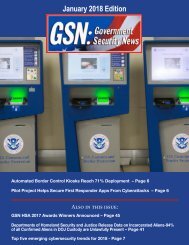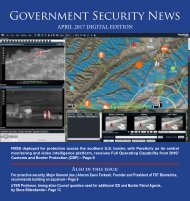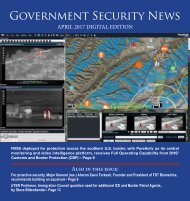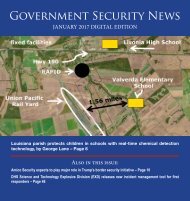GSN_Apr_FINAL+links
You also want an ePaper? Increase the reach of your titles
YUMPU automatically turns print PDFs into web optimized ePapers that Google loves.
Cyber Threats & Solutions<br />
BeyondTrust survey links breaches to<br />
aging federal infrastructure<br />
Federal Government loses $637 Million to Breaches annually<br />
PHOENIX, AZ – May 3, 2017 – BeyondTrust,<br />
the leading cyber-security<br />
company dedicated to preventing<br />
privilege misuse and stopping unauthorized<br />
access, today unveiled the<br />
results of its Federal Cyber-Security<br />
Threat Survey Report 2017. Based<br />
on a comprehensive survey of senior<br />
Federal IT professionals, the study<br />
exposes an aging Federal computing<br />
infrastructure which has led to an environment<br />
with an alarmingly high<br />
risk of breaches.<br />
105 senior IT professionals working<br />
for federal agencies were asked about<br />
their computing infrastructure, security,<br />
breaches and IT modernization.<br />
A summary of the findings is included<br />
below.<br />
Federal IT managers concerned<br />
about antiquated infrastructure.<br />
An overwhelming majority of Federal<br />
IT managers (81 percent) say aging<br />
IT infrastructures have a somewhat<br />
to extremely large impact on their<br />
cyber-security risk. Further, three of<br />
five (61 percent) say aging infrastructure<br />
is a roadblock to achieving federal<br />
cyber-security mandate compliance.<br />
We found ample examples of aging<br />
infrastructure in our survey. For<br />
example, a surprising 47 percent of<br />
Federal agencies still use Windows<br />
XP, driving a third of respondents (35<br />
percent) to report that this kind of aging<br />
infrastructure had a somewhat to<br />
large impact on their ability to affect<br />
vulnerability patching.<br />
The impacts of aging federal infrastructure<br />
don’t stop there …<br />
• Three of four say aging infrastructure<br />
is a somewhat to extremely large<br />
risk to their ability to achieve their<br />
mission.<br />
• The biggest impacts include inefficiency,<br />
increased cyber risk and problems<br />
with compliance.<br />
• Specific to cyber-security, the top<br />
impacts of an aging infrastructure are<br />
difficulty with patching, password<br />
management and privileged account<br />
management (PAM).<br />
• Respondents cite aging infrastructure<br />
as the top roadblock in the way<br />
of achieving federal cyber-security<br />
mandates<br />
Aging Infrastructure Leads to<br />
Breaches<br />
Aging infrastructure is not just a<br />
problem in theory; aging infrastructure<br />
makes federal systems more vulnerable<br />
to attack, which has led to an<br />
environment that could be rife for<br />
breaches.<br />
• 42 percent have experienced a<br />
data breach within the past 6 months.<br />
• A staggering one in eight has experienced<br />
a data breach within the<br />
past 30 days.<br />
• Put another way, the typical federal<br />
IT system experiences one breach<br />
every 347 days.<br />
• Respondents report that the<br />
typical data breach costs more than<br />
$91,000.<br />
• The total cost due for data breaches<br />
is $637 million every year.<br />
• The most frequently reported<br />
costs include loss of productivity,<br />
loss of reputation and pure monetary<br />
damages.<br />
Privileged Account Management:<br />
Gap Between Theory and Practice<br />
We asked respondents what tools<br />
were most important to them in<br />
terms of securing their information<br />
environment. Here they ranked privileged<br />
access management and vulnerability<br />
patching as most important.<br />
This is significant as these technolo-<br />
gies restrict user privileges and close<br />
off security weaknesses in systems.<br />
Yet, despite understanding the importance<br />
of such measures, most<br />
(56 percent) use alternate solutions<br />
to manage privileged passwords and<br />
nearly two-thirds (63 percent) report<br />
less than fully mature vulnerability<br />
remediation programs. In fact, 6 percent<br />
have NO remediation plan, and<br />
another 14 percent do only the bare<br />
minimum required by compliance<br />
mandates.<br />
What IT Can Do Mitigate<br />
the Security Risk of<br />
Aging Federal Infrastructure<br />
The BeyondTrust 2017 US federal<br />
government study points to four best<br />
practices that any agency can implement.<br />
• Manage privileged credentials<br />
with greater discipline, eliminate<br />
administrator rights and enforce<br />
least privilege<br />
Thirty percent of respondents believe<br />
that insider threats pose a significant<br />
threat and 35 percent believe<br />
their users have more privileges than<br />
are required. To mitigate insider<br />
threats and the exploitation of privileges,<br />
adopt a least privilege model<br />
by removing admin rights from users<br />
and storing all privileged credentials<br />
in a secure safe. Known escalation attacks<br />
have been around for years and<br />
are still being used. These attacks require<br />
local administrator rights. It’s<br />
not just about insiders. Enforcing<br />
least privilege prevents lateral movement<br />
within an organization if a<br />
breach does occur.<br />
• Isolate Legacy Systems to reduce<br />
attack surfaces<br />
Modernization of federal IT infrastructure<br />
is a priority for most survey<br />
34 35<br />
respondents, but realistically this will<br />
not happen quickly. These aging systems<br />
have known risks. Reduce the<br />
attack surface by isolating legacy systems.<br />
Segment these systems to force<br />
all traffic through a proxy to reduce<br />
attack vectors. Deploy an automated<br />
password and session management<br />
solution that provides secure access<br />
control, auditing, alerting and recording<br />
for any privileged account. This<br />
will provide segmented access to critical<br />
systems, manage passwords, and<br />
monitor when tasks and operations<br />
are committed to a managed system.<br />
• Improve the maturity of vulnerability<br />
management through automated<br />
patching<br />
Even in today’s sophisticated threat<br />
landscape, the majority of attacks target<br />
known vulnerabilities that can be<br />
easily patched. Effective patch management<br />
goes a long way in reducing<br />
a network’s overall attack surface. To<br />
be truly effective, patch management<br />
requires intelligent prioritization and<br />
broad coverage for common business<br />
applications. To improve the efficiency<br />
and effectiveness of an agency<br />
patch process deploy a solution<br />
that provides integrated, automated<br />
patching. Implementing a solution<br />
that delivers analytics and trending<br />
across the threat lifecycle for multidimensional<br />
reports on assets, vulnerabilities,<br />
attacks and remediation<br />
allows prioritized patch management<br />
More on page 44















